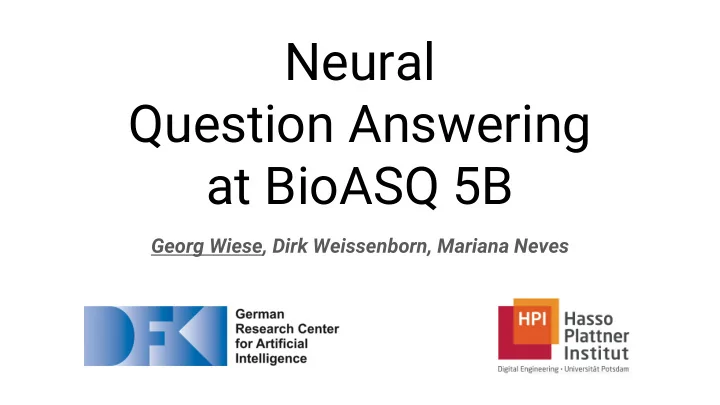

Neural Question Answering at BioASQ 5B Georg Wiese, Dirk Weissenborn, Mariana Neves
Motivation ● Neural question answering (QA) systems are end-to-end trainable machine learning models which achieve top performance in domains with large training datasets ● We apply an extractive neural QA system (FastQA [1]) to BioASQ 5B Phase B (list & factoid questions) ● Extractive QA : Answer is given as start and end pointers in the context (snippets) 2
Network Architecture Original FastQA [1] Our Architecture 3
Network Architecture Input Layer ● GloVe & character embeddings (like the original FastQA) Biomedical embeddings [3] ● Question type features ● Original FastQA [1] Our Architecture 4
Network Architecture Output Layer Change start probability activation ● from softmax to sigmoid ● -> Multiple starts can be selected for list questions For each selected start, select the ● corresponding end pointer via softmax Original FastQA [1] Our Architecture 5
Network Architecture Original FastQA [1] Our Architecture 6
Training Procedure Problem : Neural QA typically requires ~10 5 questions to train ● Datasets of such scale exist in the open domain, e.g. SQuAD [2] with ● ~10 5 factoid questions on Wikipedia articles We train in two steps: ● 1. Pre-training on a large (~10 5 questions) open-domain dataset (SQuAD) 2. Fine-tuning on BioASQ (~10 3 questions) 7
Systems ● We trained five models using 5-fold cross validation on all available training data ● We submitted two systems : ○ Single : Best single model according to its respective development set Ensemble : Ensemble of all five models (averaging scores before ○ sigmoid/softmax activation) 8
Results Factoid Results : Our system won 3/5 batches ● Averaged over the five ● batches, our system (ensemble) was 1.5 percentage points above the best competitor 9
Results List Results : Our system won 2/5 ● batches ● On average, the best competitor performed 3.4 percentage points better than our ensemble model 10
Discussion Strengths : Competitive performance , despite: Less feature engineering than traditional QA systems ● ● A less domain-dependent architecture , because we don’t rely on domain-specific structured resources Limitations : ● Extractive QA cannot generate answer which are not explicitly mentioned in the snippets -> No yes/no & summary questions 11
References [1] Weissenborn et al.: “Making Neural QA as Simple as Possible but not Simpler” [2] Rajpurkar et al.: “SQuAD: 100,000+ Questions for Machine Comprehension of Text” [3] Pavlopoulos et al.: “Continuous Space Word Vectors Obtained by Applying Word2Vec to Abstracts of Biomedical Articles” 12
Thank You. Questions? Related CONLL paper : “Neural Domain Adaptation for Biomedical Question Answering” Contact : georg.wiese@student.hpi.de 13
Recommend
More recommend